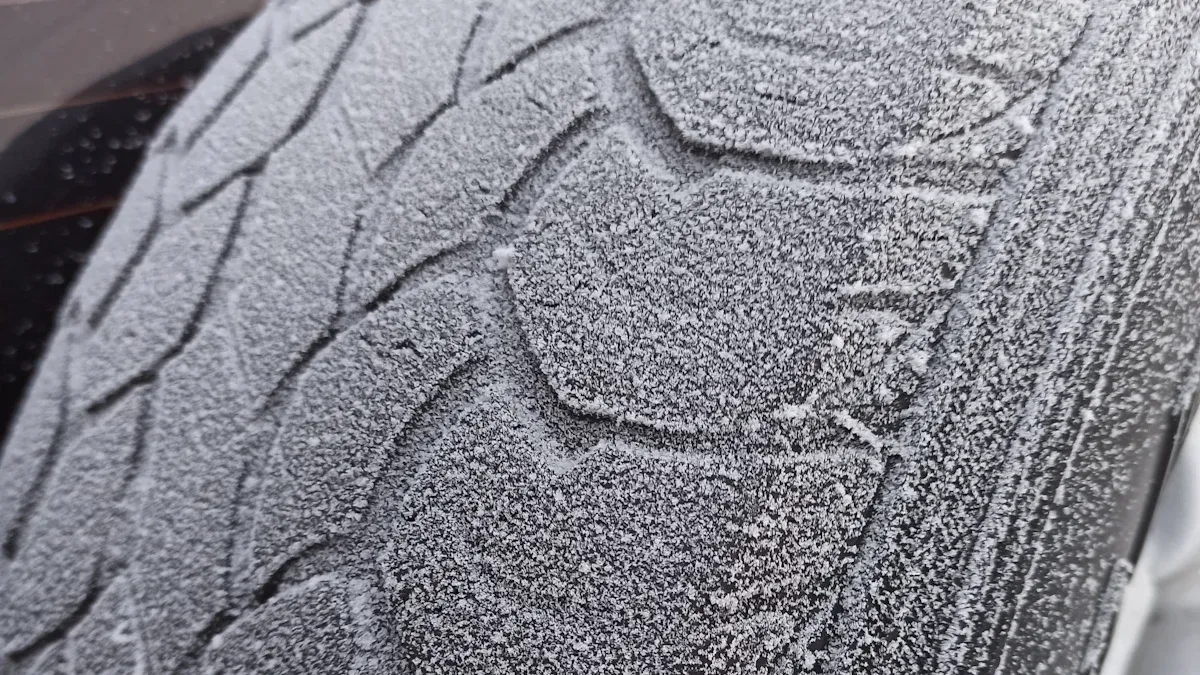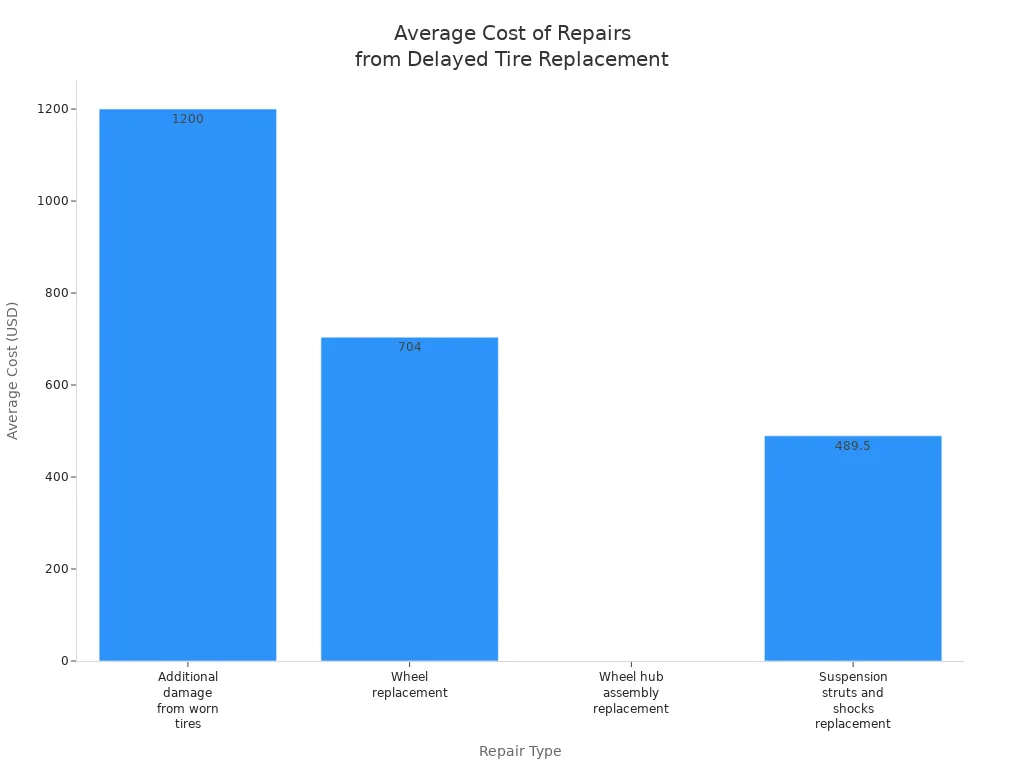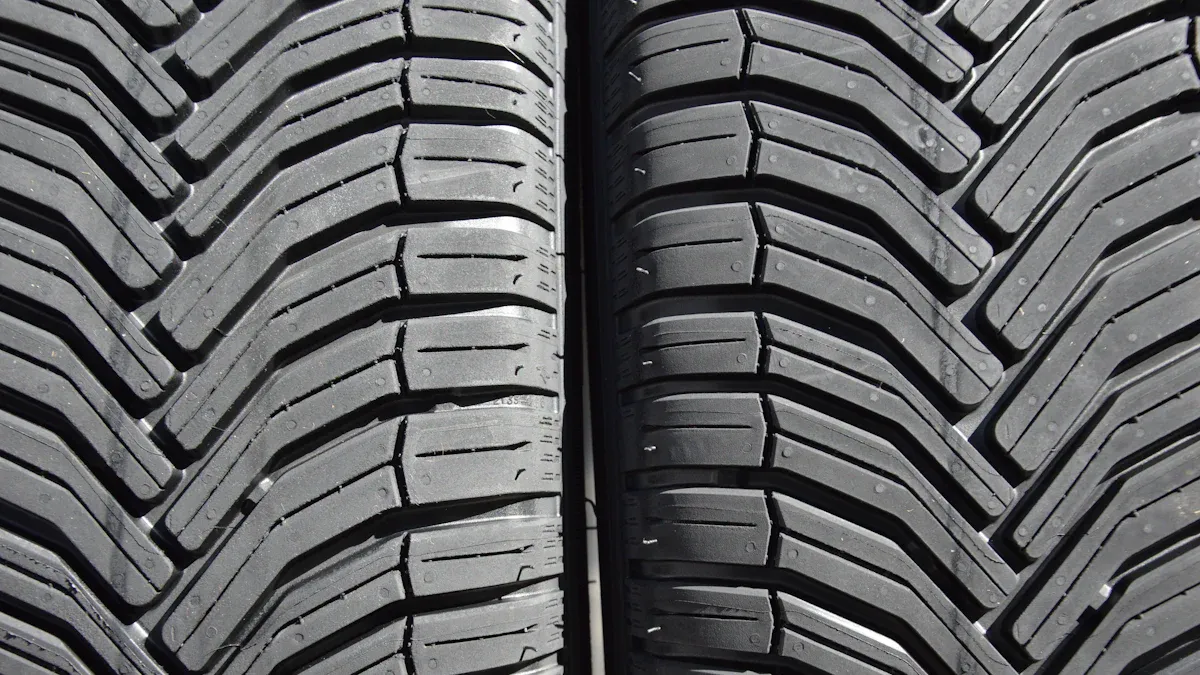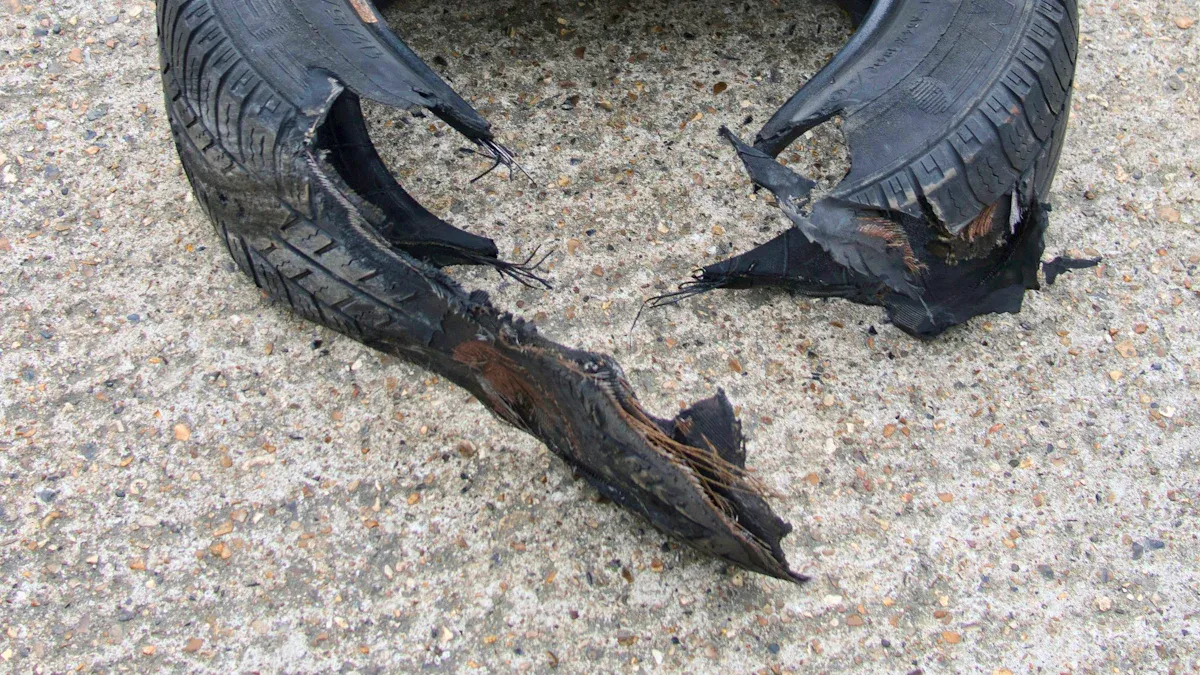
You can spot tire wear fast with easy ways to check right at home. Regular tire checks keep you safe and help you avoid breakdowns. The National Highway Traffic Safety Administration says worn tires cause about 11,000 accidents each year in the U.S.
Try simple checks now—don’t wait for problems to get serious.
Key Takeaways
Check your tire tread often. Use easy tests like the penny or quarter test. This helps you find wear before it gets dangerous.
Look for cracks, bulges, uneven wear, and damage on your tires. This can help you avoid blowouts and expensive repairs.
Replace tires if tread is less than 2/32 inch. Change them if you see damage. Get new tires if they are over six years old. This keeps you safe on the road.
Tire Wear and Safety
Safety Risks
You might not think about tire wear every day, but it can quickly turn into a big problem. Worn tires make driving much more dangerous. Here are some of the most common safety risks you face when you ignore tire wear:
Blowouts can happen because worn tires build up too much heat. You could lose control of your car in seconds.
Hydroplaning becomes more likely since old tread cannot push water away. Wet roads get slippery fast.
Stopping distances get longer. Worn tires do not grip the road well, so you need more space to stop.
Handling gets worse, especially in rain or snow. Your car may slide or skid during sharp turns or emergency stops.
Punctures and slow leaks happen more often. Thin tread cannot protect against nails or sharp debris.
Tip: Regular checks help you spot these risks early and keep tire safety a top priority.
Cost of Delay
Waiting too long to replace worn tires does not just put you at risk—it can hit your wallet hard. Delayed tire replacement often leads to expensive repairs and even accidents. Take a look at the average costs below:

Replacing wheels can cost around $700.
Damage to rotors and hubs adds another $500 to $1,200.
Even a simple tire repair is much cheaper than fixing damage from a blowout or accident.
If you ignore tire wear, you risk losing control, facing higher repair bills, and even causing accidents. Early detection saves you money and keeps you safe on the road.
Tread Depth

Keeping an eye on your tire tread is one of the easiest ways to stay safe on the road. You do not need fancy equipment or special training. You can use simple tools you already have at home, or try new technology for even better results.
Penny Test
The penny test is a classic way to check your tire tread. Grab a penny and place it into the groove of your tire tread with Lincoln’s head facing down. If you can see the top of Lincoln’s head, your tread is worn down to 2/32 of an inch or less. That means you need to replace your tires right away.
Most states in the U.S. set the legal minimum tire tread depth at 2/32 of an inch. Some states, like California and Idaho, allow even less, while Texas requires 3/32 inch for inspections. Even though 2/32 inch is legal in most places, experts say it is not always safe. Tires with less than 4/32 inch tread depth lose grip, especially on wet roads. So, the penny test helps you spot the legal limit, but you should think about safety first.
Tip: If you see Lincoln’s whole head, do not wait—replace your tires as soon as possible.
Quarter Test
Want an earlier warning? Try the quarter test. Take a quarter and put it into the tire tread groove with Washington’s head down. If you can see the top of his head, your tread is at 4/32 inch or less. Your tires are still legal, but they may not be safe, especially in rain or snow.
Safety experts, including AAA, recommend replacing tires at 4/32 inch for summer driving and 6/32 inch for winter. The quarter test gives you a heads-up before your tires reach the legal minimum. It is quick, easy, and helps you avoid risky driving conditions.
Here’s a simple table to compare the two tests:
Test | Tread Depth | What You See | What It Means |
|---|---|---|---|
Penny Test | 2/32 inch | Lincoln’s head visible | Replace your tires now |
Quarter Test | 4/32 inch | Washington’s head visible | Replace soon for safety |
Note: Coin tests are great for quick checks, but they only give you an estimate. They might miss uneven wear or other problems.
Tire Tread Scanner
If you want more accurate results, try a tire tread scanner. New handheld devices use laser imaging or structured-light algorithms to measure tire tread depth. These scanners look like small, sturdy gadgets with a digital screen. You hold the device over the tire, and it scans the grooves without touching the rubber. The scanner automatically recognizes the grooves and measures the depth in seconds.
You can use these devices on their own or pair them with your phone or tablet. The app shows detailed 3D models of your tire tread, stores inspection reports, and even tracks wear over time. This technology works for drivers, mechanics, and anyone who wants reliable results.
Compared to old mechanical gauges, tire tread scanners offer higher accuracy and faster measurements. You do not need to guess or write down numbers. The device displays results instantly, and you can save them for future checks. Laser and camera-based systems capture many data points, reducing errors and giving you a clear picture of your tire’s health.
Callout: Tire tread scanners help you spot problems early, keep records, and make smart decisions about when to replace your tires. They are efficient, easy to use, and connect to your devices for extra convenience.
If you want the best inspection, try a handheld tire tread depth device. It uses non-contact scanning and automatic groove recognition. You can use it alone or with your phone. The device shows results on its screen and in the app. You get inspection reports, high accuracy, and easy connectivity. This tool is perfect for anyone who wants fast, reliable tire tread checks.
Tread Wear Bars
Identifying Bars
You might not notice tread wear bars at first glance, but they play a big role in tire safety. Tread wear bars are small, raised strips of rubber that sit inside the grooves between the tread blocks on your tires. These bars run across the width of the tire and look like tiny bridges connecting the tread patterns. You can spot them by looking closely at the grooves or by running your finger along the tread. If you feel a bump or see a thin line stretching from one side of the tread to the other, you have found the tread wear bars.
Most tires have several tread wear bars spaced evenly around the tire. This design helps you check for even wear. If you see the bars in more than one spot, you know the tread is wearing down the same way all around. Tread wear bars make it easy to check your tires without any tools.
Tip: Check your tires in good light. Dirt or mud can hide the tread wear bars, so wipe the tire clean first.
Replacement Signs
Tread wear bars give you a clear sign when it is time to replace your tires. When the tread wears down and becomes level with the tread wear bars, your tire has reached the legal minimum tread depth—usually 2/32 of an inch in most states. At this point, your tires cannot grip the road well, especially in rain or snow.
You should not wait until the tread is completely flush with the bars. If you notice the tread wear bars are easy to see or feel, your tires are almost worn out. Driving on tires with low tread can lead to longer stopping distances, poor handling, and a higher risk of blowouts.
Here’s a quick checklist to help you decide:
Can you see the tread wear bars across the tire?
Does the tread feel even with the bars when you run your finger over them?
Are the bars visible in more than one groove?
If you answer yes to any of these, it is time to replace your tires. Tread wear bars give you a simple, visual cue to keep you safe on the road.
Physical Damage

Your tires can show many warning signs before they fail. You do not need special tools to spot most problems. Just look closely and pay attention to how your car feels when you drive. Catching physical damage early helps you avoid sudden blowouts and keeps you safe.
Cracks and Bulges
You might notice cracks, bulges, or even blisters on your tires. These are some of the most serious signs of wear. Here are the most common types of physical damage you should watch for:
Cracks or cuts in the sidewall. These often come from aging, sunlight, or hitting sharp objects.
Bulges or bumps on the sidewall. These mean the inside of the tire is damaged, usually from hitting a curb or pothole.
Punctures or nails stuck in the tread.
Cracks on the tread surface. These happen when the rubber gets old or worn out.
Blisters or bubbles, which can form after a hard impact.
If you see a bulge or deep crack, stop driving and get your tire checked right away. Bulges mean the inside cords have broken. This makes a blowout much more likely. Even a small bump can turn into a big problem at highway speeds.
Sometimes, you might spot cords showing through the rubber. This is a clear sign your tire is unsafe. If you feel strong vibrations or thumping while driving, check your tires for damage. These are not just minor issues—they are warning signs that you need a replacement now.
Uneven Wear
Uneven tire wear is another problem you cannot ignore. It does not just make your tires look bad. It affects how your car handles and how much gas you use. Here are some patterns you might see:
Edge wear from too little air pressure.
Cupping or scalloping, which looks like dips or high spots around the tire. This often means your suspension or balance is off.
One-sided wear, where one edge wears down faster. This usually points to a wheel alignment problem.
When your tires wear unevenly, your car does not grip the road as well. You might notice your steering feels loose or your car pulls to one side. Uneven wear also makes your engine work harder, so you burn more fuel. Even a small alignment issue can lower your gas mileage by several miles per gallon.
Tip: Rotate your tires and check your alignment often. This helps prevent uneven wear and keeps your ride smooth.
If you spot any of these signs of wear, do not wait. Uneven wear, cracks, bulges, or cords showing all mean your tires need attention. Regular checks help you catch problems early and avoid costly repairs or dangerous blowouts.
Tire Age
DOT Code
You can find out how old your tires are by checking the DOT code on the sidewall. Every tire has a DOT number that starts with “DOT.” The last four digits tell you the week and year the tire was made. For example, if you see “3020,” your tire was made in the 30th week of 2020. If your tire has only three digits at the end, it was made before 2000 and should be replaced right away.
Here’s a quick guide to reading the DOT code:
DOT Code Segment | Meaning | Example |
|---|---|---|
First 2-3 characters | Manufacturer and plant code | U2LL |
Next 4-6 characters | Tire size and brand details | LMLR |
Last 4 digits | Date of manufacture (week and year) |
Tip: Always check the DOT code before you buy new or used tires. This helps you avoid getting old or unsafe tires.
When to Replace
Tires do not last forever, even if they look good. Most experts say you should replace your tires every six to ten years, no matter how much tread is left. Some car makers, like Ford and Nissan, recommend changing tires after six years. Michelin says never use tires older than ten years. After five years, get your tires checked by a pro every year.
Environmental factors can make tires age faster. Hot weather, road salt, and strong sunlight all speed up rubber breakdown. Winter cold can stiffen tires and cause cracks. Road salt and moisture can weaken the sidewalls and lead to blowouts.
Heat makes tires brittle and weak.
Road salt and water cause cracks and damage.
Sunlight dries out rubber, leading to surface cracks.
Cold weather stiffens tires and reduces grip.
If your tires are old or show signs of aging, do not wait—replace tires to stay safe.
Regular Inspection Tips
Monthly Checks
You can keep your tires in top shape with a simple monthly routine. Start by checking your tire pressure when the tires are cold. Use the numbers from your car’s door sticker or manual. Low or high pressure can hurt your tire condition and make driving unsafe.
Next, look at your tread depth. You can use a quarter or a tread depth gauge. If the tread is too low, it’s time for new tires. Scan the surface for cracks, bulges, or cuts. These signs mean your tires need attention. Don’t forget to check for uneven wear or anything stuck in the tread.
Here’s a quick checklist for your monthly tire maintenance:
Check tire pressure.
Measure tread depth.
Look for cracks, bulges, or cuts.
Inspect for uneven wear.
Listen for odd noises or feel for vibrations while driving.
Tip: If you spot any damage or something feels off, visit a tire shop or mechanic right away.
Tire Rotation
Rotating your tires helps them wear evenly and last longer. Most experts suggest rotating tires every 5,000 to 8,000 miles. This often matches up with oil changes, so it’s easy to remember. Different cars need different rotation patterns, so check your manual or ask a pro.
Regular rotation can boost tire life by up to 40%. It also helps your car handle better and saves you money on gas. If you notice uneven wear or your car pulls to one side, get your tires rotated and checked for alignment.
If you find a problem during your inspection, have a technician check the tire. Small issues can sometimes be fixed, but big problems or old tires mean you need a replacement. Always make sure all your tires, including the spare, are safe before you drive.
You can spot tire wear by checking tread depth, looking for cracks or bulges, and watching for uneven wear. Replace tires if tread is below 2/32″, you see damage, or they are over six years old. Regular checks and quick action keep you safe and your car running smoothly. 🚗
FAQ
How often should I check my tires for wear?
You should check your tires once a month. Look for low tread, cracks, or bulges. Quick checks help you catch problems before they get serious.
Can I trust tire ratings when picking new tires?
Yes, tire ratings help you compare grip, tread life, and safety. Always check ratings before you buy new tires for your car.
What should I do if I see uneven tire wear?
Schedule a wheel alignment and rotate your tires. Uneven wear means your car may not drive straight or handle safely.
See Also
The Importance Of Measuring Tire Tread Depth For Safety






